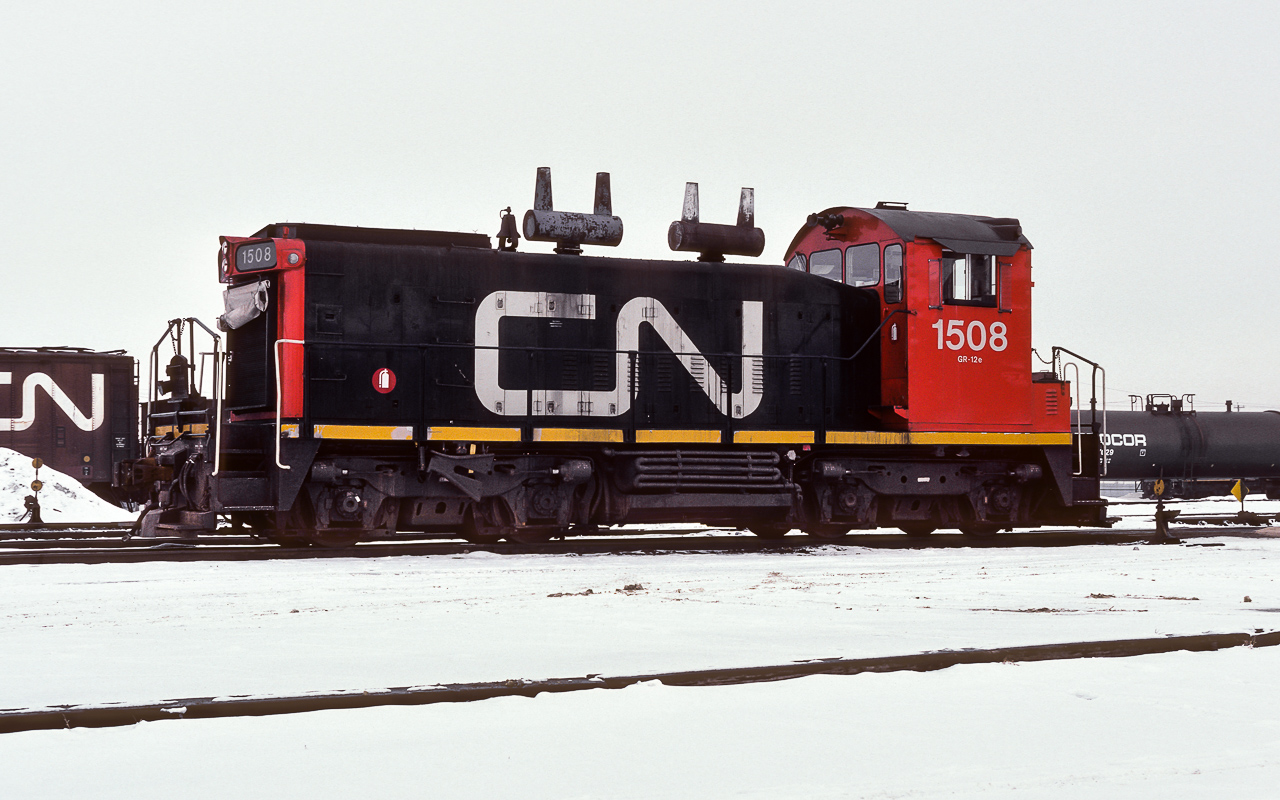|
Caption: I stopped in at the downtown city yard on a Saturday morning knowing that the majority of crews here have the weekend off. I surely expected to find several switch engines and that was certainly the case. This is the west leads goat parked in its usual spot by the yard office which is just out of the picture to the right. They will be one of the few jobs working today. The usual routine for them will be switching the yard until around lunch and then after lunch take a transfer to the NAR and bring one back for interchange with the CPR. The CP yard at that time is behind me in this picture (south side 104th ave.). The only thing today remaining of both railroads in downtown is the CN tower, which even that is no longer owned by CN. Behind the black Procor tank, parked on the shop track, the 1263, 1264, 1291 and 1507 are idling and waiting for their next call to duty. During my time at CN, the typical goats at the city yard will have been a thirteen hundred for the west lead and on the shop track there will have been the 7100 number series SW8's with the occasional SW900 in the 7200 series. Checking the CNRHA, the 1508 only has 5 years to go from this date before retirement and it seems there was no second life for this unit.
|



Nice pic Mr. Priest!
I asked an old hogger who worked the city yard job what they called the little switchers, and he informed me they called them “Glass-Sass’s.” Thanks KK for the info! ; ]
Thanks.
I should add that the west lead was one of the best if not the best switching job in the Edmonton terminal. The reason being the city yard was bowl shaped. A 4 man crew was standard with the foreman kicking cars and a high and low switchman on the lead. Rarely were hand brakes required. It was quite the operation to watch as cars were rolling to many tracks as the switchman read their lists and lined the appropriate switches. Cars sent into an empty alley would roll back and forth in the bowl until coming to rest. Cars coming down the lead to slow and were likely not going to make it to clear were easily pushed by a switchman because of the small hill into the tracks. An art that has been lost when you watch today’s crews switch.
Thanks for posting this shot of the 1508. When I worked Sudbury Yard in 1969, all 5 of CN’s 1500′s (1504-1508) were assigned there. These units would out pull all the other 12-1300 series units also working the yard as the 1500′s weighed in at 246,000 pounds as compared to 222/223,000 for the others. It may not sound like a big difference, but when dragging 4000 tons of ore up to Clarabelle, you felt the difference.
Sudbury yard (Algo) was also a saucer type of yard, but if you kicked a car in too hard, it would roll right back out to you. Kept you on your toes!! I did a lot of running back then with my preferred 2×2 hunk of wood made into a perfect break stick you could jam under a wheel to stop an oncoming car. Like you said Larry, the art of railroading is lost.
Thanks for your comment First954, so good to read other personal stories from railroading.
Same problem at the Edmonton city yard. The east side of the yard had a steeper grade and if the cars were rolled in to fast from the west they would go up the hill and come right back at you. No hitting for the fences, the cars only needed a good bunt when switching. Heh heh.
While the use of wood ‘wheel chocks’ and pushing cars by hand are no longer a daily part of switching (I may have done both on a few surprisingly recent occasions), kicking cars still is, and it’s still an art form.
I’d say kicking is more like curling than baseball, and you really have to know your yard and take into account what you are kicking (loads vs empties, how many cars in this cut, is the wind with you, how many switches are they going through) in order to give them just the right draw weight.
‘Kicking and catching’ is no longer practiced on CN as we are not allowed to get on and off moving equipment anymore.
Some yards are terrible to switch in. McLennan, AB is one of the worst, being both curved and on a hill, so you can’t see far into the tracks and everything will roll back at you no matter which end of the yard you are on.
The ‘drop’, also known as a ‘running switch’ or ‘flying switch’ is another once common switching move that is now rare, but when done properly it is perfectly safe and can really get you out of a jam.
We have a car moving bar hidden at a strategic location, just in case the cars stall on the switch and trap the engine in the spur.
I had a hunch that weight was the reason CN renumbered that small group of SW1200RS units out of the 1200′s into the 1500′s. The only thing different I could find about them was the extra weight compared to other 1200′s built before and after. I think the GTW 1500′s were of similar weight, hence the renumbering.